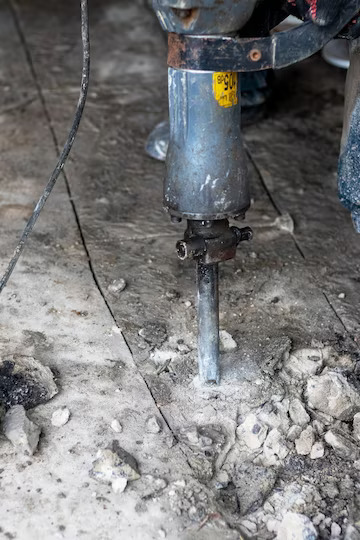Mudjacking and polyjacking are two standard techniques used in concrete repair and leveling. Both methods address uneven surfaces, sinking slabs, and other concrete-related problems. Each approach has advantages and disadvantages, making them suitable for different situations. This comprehensive analysis will delve into the pros and cons of mudjacking vs polyjacking to help you make an informed decision based on your specific needs.
Mudjacking:
Mudjacking, also known as slab jacking, is an effective and cost-efficient method for lifting and leveling sunken concrete slabs. It involves injecting a slurry mixture beneath the slab to raise it back to its original position, restoring stability and safety. The key benefits of mudjacking include its affordability, quick turnaround time, and minimal disruption to the surrounding area. It’s commonly used for sidewalks, driveways, and foundations that have settled due to poor soil conditions. However, the method has limitations, such as being less suitable for heavy load-bearing surfaces or situations where long-term stability is crucial compared to more advanced methods like polyurethane foam injection.
Pros:
- Cost-Effective: When it comes to the cost involved in mudjacking vs polyjacking, mudjacking is often considered more cost-effective than polyjacking. The materials used in mudjacking are typically a mixture of soil, water, and cement, making it a budget-friendly option for homeowners and businesses looking to repair concrete surfaces without breaking the bank.
- Proven Method: Mudjacking has been a reliable and widely used method for several decades. Its track record in addressing issues like sunken driveways, sidewalks, and patios has established it as a proven and trusted technique in the construction and repair industry.
- Environmentally Friendly: The materials used in mudjacking are generally considered environmentally friendly. The mixture primarily consists of natural elements, reducing the environmental impact compared to certain polyjacking materials.
- Quick Process: Mudjacking is a relatively quick process. Once the mixture is injected beneath the slab, it hardens and stabilizes the concrete quickly. This means minimal disruption for homeowners or businesses, as the repaired area can be used soon after the procedure.
Cons:
- Weight and Intrusiveness: The mixture used in mudjacking can be heavy, which may pose a challenge if the soil underneath is unstable. The weight of the mud mixture can exacerbate the issue in some instances, potentially leading to further settling.
- Limited Aesthetics: Mudjacking may not be the ideal choice for surfaces where aesthetics are crucial. While it effectively addresses functionality issues, the appearance of the repaired area might need to match the surrounding concrete perfectly.
- Potential for Erosion: In cases where the soil underneath is prone to erosion, there’s a risk that the mud mixture could wash away over time. This can compromise the long-term stability of the repaired concrete.
Polyjacking:
Pros:
- Lightweight Material: Polyjacking involves injecting polyurethane foam beneath the concrete slab. This material is lightweight compared to the mud mixture used in mudjacking, making it suitable for situations where soil stability is a concern.
- Precision and Control: Polyjacking provides more control over the lifting process. Contractors can precisely adjust the amount of foam injected to achieve the desired lift, offering higher accuracy in leveling the concrete surface.
- Water Resistance: Polyurethane foam is water-resistant, making it a durable solution for areas exposed to moisture or water. This resistance helps prevent future issues related to water damage, such as erosion or washout.
- Aesthetically Pleasing: Polyjacking is often considered more aesthetically pleasing. The injection holes used in the process are smaller, and the foam can be color-matched to the existing concrete, resulting in a less noticeable repair.
Cons:
- Costlier Option: One of the main drawbacks of polyjacking is its higher cost than mudjacking. The materials involved, including polyurethane foam, contribute to the overall expense, making it less budget-friendly for some homeowners or businesses.
- Limited History: Polyjacking is a relatively newer technique compared to mudjacking. While it has gained popularity, it has a more extensive history of successful applications, leading to a perception of being less tried and tested.
- Potential for Over-Lifting: In some cases, there’s a risk of over-lifting with polyjacking. If not done with precision, excessive foam injection can cause the concrete to rise unevenly, creating a new set of problems.
Conclusion:
The choice between mudjacking vs polyjacking ultimately depends on specific project requirements, budget constraints, and the desired outcome. Mudjacking, with its cost-effectiveness and long-standing history, may be preferable for straightforward leveling tasks.
On the other hand, polyjacking offers precision, water resistance, and enhanced aesthetics, making it a more suitable option for projects where these factors are critical. Before making a decision, it’s crucial to consult with a professional contractor who can assess the specific conditions of the concrete issue and recommend the most appropriate solution. Both mudjacking and polyjacking have their merits and drawbacks, and understanding them will empower property owners to make informed choices for effective concrete repair and leveling.
When choosing a mudjacking company, Zavza Seal LLC stands out as the top choice. With their unmatched expertise, commitment to quality, environmentally friendly practices, cost-effective solutions, customized approach, and excellent customer service, they have all the qualities you should look for in a mudjacking service provider. When you choose us, The Mudjacking contractors, you can be confident that your concrete surfaces will be restored to their original condition, and your satisfaction will be guaranteed.

